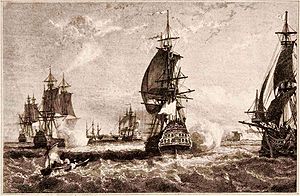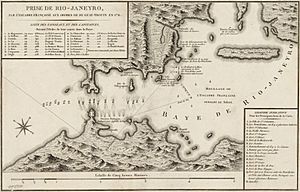Battle of Rio de Janeiro facts for kids
Quick facts for kids Battle of Rio de Janeiro |
|||||||
|---|---|---|---|---|---|---|---|
| Part of the War of the Spanish Succession | |||||||
 |
|||||||
|
|||||||
| Belligerents | |||||||
| Commanders and leaders | |||||||
|
René Duguay-Trouin | ||||||
| Strength | |||||||
| 14–15,000
Ships: 4 ships of the line |
+3,800
Ships: 7 ships of the line 5 frigates 1 galliot 3 bomb-ketches |
||||||
| Casualties and losses | |||||||
| ~300 | |||||||
The Battle of Rio de Janeiro was a big attack in September 1711. A French fleet, led by René Duguay-Trouin, raided the port of Rio de Janeiro. This happened during the War of the Spanish Succession. The Portuguese defenders were not ready, even though they had more soldiers. The city's governor and a fleet admiral could not stop the French. Rio de Janeiro had to pay a lot of money to the French. This payment saved the city from being destroyed.
Contents
Why the French Attacked Rio
There were several reasons why the French planned this attack.
A Commander's Personal Goal
First, the French commander, Duguay-Trouin, needed money. He was almost broke. A successful raid would help him get rich again.
A Matter of French Honor
Second, it was about honor for France. The year before, another French privateer named Jean-François Duclerc had tried to attack Rio. That attack failed badly. Duclerc and 600 of his soldiers were captured. They were held in very poor conditions. The Portuguese had promised to exchange these prisoners. This was part of a treaty from 1707. But they refused to do so. Duclerc was also killed in prison in May 1711. The French wanted to free their prisoners. They also wanted to get revenge for Duclerc's death.
Getting Ready for Battle
In December 1710, King Louis XIV of France approved Duguay-Trouin's plan. The king gave him a fleet of 17 ships. These ships carried 738 cannons and 6,139 men. The French government did not have enough money for the ships. So, Duguay-Trouin had to find private investors. He got a lot of help from the Count of Toulouse.
The French prepared their ships in secret. They wanted to trick the British Navy. The British were allies of Portugal. To do this, the ships were prepared in different harbors. They left at different times. Then, they met up at sea near La Rochelle on June 9, 1711.
However, British spies found out about Duguay-Trouin's plan. They sent a message to warn the Portuguese. This warning went to Portugal and to Rio. The British also sent their own fleet. This fleet, led by John Leake, tried to stop Duguay-Trouin. But they arrived too late.
The Battle Begins
Even with the British warning, the French arrival was a surprise. They appeared in Rio's harbor on September 12. The British news had arrived in August. This made Governor Francisco de Moraes de Castro call out his militia. He also increased the city's defenses. Rumors of ships near Cabo Frio in early September also raised the alarm.
A Sudden Attack
But on September 11, the governor told the militia to stand down. This was just as Duguay-Trouin was getting ready to attack. The French commander, Courserac, led his ships directly into Rio Bay. They sailed between the forts at the harbor entrance. They went straight for seven Portuguese warships. These warships were anchored there.
The Portuguese fleet commander, Admiral Gaspar da Costa, could do little. He ordered his ships to cut their anchor cables. He hoped they could move away. But three battleships got stuck. The Portuguese destroyed them to stop the French from capturing them. The French captured one Portuguese ship and burned it.
Forts and Casualties
The forts fired at the French fleet. But they were not fully manned. This was because of the order to stand down. The forts still caused some damage. About 300 French soldiers were hurt. The French ships soon moved out of range.
After three days of bombing, the French landed 3,700 men. They prepared to attack the city. Governor Castro-Morais had tried to fortify Rio. He had done this after earlier French attacks. But his command of the defense was weak. The city's defenses broke under the French bombing.
On September 21, Moraes held a meeting. He ordered the city's defenders to hold their ground. But that night, many militia members started to leave. Soon, everyone, including the governor, fled the city. In the confusion, the French prisoners from Duclerc's expedition escaped from prison.
After the Battle
Duguay-Trouin was getting ready to storm the city. Then, one of Duclerc's escaped men arrived. He told Duguay-Trouin that the defenders had fled. Over the next few days, the French took control of all the strong points around the bay. But they could not find the city's gold supply.
Ransom and Loot
Duguay-Trouin learned that more Portuguese soldiers were coming. These reinforcements were from São Paulo. They were led by António de Albuquerque. Duguay-Trouin threatened Moraes. He said he would destroy the city's defenses if a ransom was not paid. Moraes agreed to pay.
When the French left the city, they took a lot of loot. It was worth about 4 million pounds. This included a shipment of African slaves. Duguay-Trouin later sold these slaves in Cayenne.
Journey Home
Two French ships sank in a storm near the Azores. One of them had a lot of treasure. The rest of the fleet arrived safely back in Brest in February 1712. The expedition was a military success for France. It was also a financial success for the people who invested in it. The French Navy showed it could attack far away places.
This battle caused problems between France and Portugal for many years.
Images for kids




